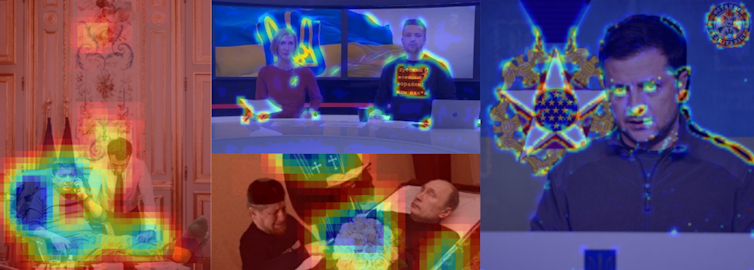
Rich Legg/E+ via Getty Images
Praveen Arany, University at Buffalo
Red light therapy is increasingly viewed as a promising treatment for wrinkles, acne, psoriasis, scars and sun-damaged skin, and as a supportive therapy for some kinds of cancer. But does red light therapy live up to the hype that it’s practically a panacea for all sorts of ailments?
Praveen Arany is a professor of oral biology, biomedical engineering and surgery at the University of Buffalo and an expert on the uses of light and lasers for medical purposes. He explains how red light therapy works, for what diseases and conditions it may be most useful, and if red light home devices are effective.
What is red light therapy?
Treatment with red light therapy involves exposure to red light at a very low dose in a hospital or clinic.
It’s also called low-power laser therapy, soft laser therapy, cold laser therapy and nonthermal LED light therapy.
The umbrella term is called photobiomodulation therapy, which covers other colors, or wavelengths, that have health benefits. These light wavelengths span the visible to the near-infrared spectrum.
Red light is easily the most popular of the photobiomodulation therapies. That’s primarily due to its availability – the treatment has been around more than three decades.
While it’s true that other colors are also clinically and commercially available, researchers are still studying them to determine exactly how effective they are. That said, green light therapy is generally used to treat migraines; yellow light for depression; and blue light to kill resistant strains of bacteria, like MRSA infections, and to treat seasonal affective disorder, a depression that typically onsets in late fall and continues through winter.

How does red light therapy work?
Put simply, red light stimulates the cells in your body, energizing them while initiating blood flow to the affected area. That, in turn, spurs healing, similar to how your body responds to a cut by clotting the blood to heal a wound.
The treatment is simple and painless. The patient, either seated or lying comfortably, is exposed to the red light for three to 15 minutes. They may experience a feeling of warmth during treatment, but it should not be uncomfortable or hot. The clinician will likely recommend eye shields.
Used correctly, red light therapy is very safe. Overdosing – staying under the light too long or receiving treatments at very high power – does not necessarily cause harm, but it might reduce or slow benefits. However, just as some people are more prone to sunburn than others, some patients may be more sensitive to this light and might see redness in the skin. Those patients should receive lower light doses during treatment.
What medical conditions can the therapy help?
Randomized, controlled clinical trials show that red light therapy can reduce pain, inflammation and tissue damage. Because all of these things are prevalent in many illnesses, photobiomodulation may be a powerful adjunct for treating a wide range of diseases.
One example is cancer. There’s now strong evidence that red light therapy can lessen pain and inflammation from radiation, chemotherapy and bone marrow stem cell transplants. Red light therapy has also reduced other complications from cancer treatment, including oral ulcers, scars and fibrosis.
Other recent human clinical studies show that photobiomodulation helps heal diabetic and burn wounds, as well as some types of ulcers. However, this therapy should not replace good wound care treatment, such as disinfection. Photobiomodulation has also worked for patients with neck and back pain and tennis elbow.
What about other uses for red light therapy?
Although not proven to be effective by randomized controlled trials with large samples, which is the gold standard of research, red light therapy has been shown to benefit patients with Parkinson’s, Alzheimer’s, multiple sclerosis, fibromyalgia, arthritis, macular degeneration, myopia and autism in clinical case reports and lab research studies.
A word of caution, however: Red light therapy may not work for all the medical conditions that proponents say it does. Red light therapy is also used for cardiovascular health, elevating mood, relieving anxiety, improving muscle performance and recovery from sports injuries, and providing anti-aging benefits to the skin. While there’s some evidence to support these types of treatments, rigorous research studies are still missing.

What about its commercial use?
This is a rapidly evolving field. Both LED and laser devices – beds, lamps, helmets and face masks – are readily available in clinical and nonclinical settings, such as medical spas, gyms and beauty salons. They’re also available for at-home use.
Laser devices are more powerful and are typically found at a hospital, clinic or doctor’s office. An LED, or light-emitting diode, is less powerful and more often used in commercial or home settings.
The general consensus is that LEDs are OK to use in commercial establishments like beauty salons and medical spas, provided practitioners receive the appropriate training. But the use of laser devices should be relegated to clinical specialists. That’s because lasers, in untrained hands, have the potential to do more damage than LEDs.
As for some home products, their quality and reliability may be questionable; they might not meet minimum quality standards of output power or wavelength.
The U.S. Food and Drug Administration appears to be moving toward more rigorous evaluations of these products, especially with lasers, but there is a critical need for a certifying agency or body to take this on. These agencies would test the devices to make sure they’re actually meeting specifications. That hasn’t happened yet, but as it stands now, several scientific and professional organizations are exploring the possibilities.![]()
Praveen Arany, Associate Professor of Oral Biology, University at Buffalo
This article is republished from The Conversation under a Creative Commons license. Read the original article.


























































